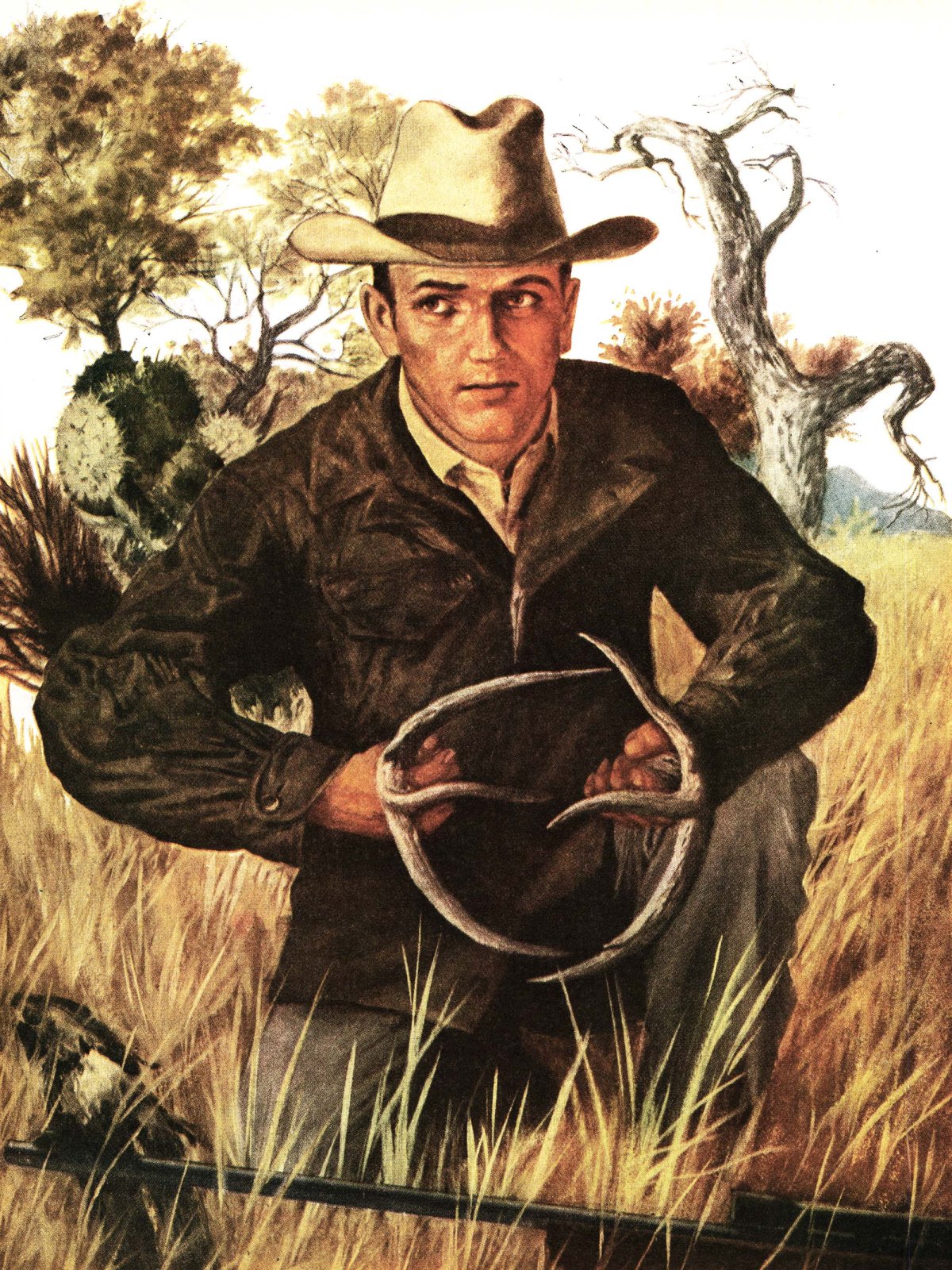Flipjacking: We Uncover the Lost Art of Cane-Pole Fishing for Bass

Daylight was only a pale promise on the horizon as Walker Cline and I pulled away from a dock on Indian Lake in western Ohio. It was completely calm and a heavy haze hung low over the water.
Walker sat in the bow fussing with tackle while I rowed across North Fork Bay. His rig consisted of a stout, 18-foot cane pole, a heavy brass spinner-bucktail combination, and a heavy line about the length of the pole. About a foot above the lure he had just clamped on a heavy sinker. We were going bass fishing, but with that outfit it seemed like a lost cause. I’m a light-tackle man myself, and was certain that this would be a wild goose chase.
“Pull hard on the right oar, and take it easy,” Walker said. “There’re some stumps just ahead we ought to try.”
I pulled right, looked over my shoulder, and in the faint light, spotted an object barely visible on the water’s surface. Farther on I picked out another.
“Now swing the boat around quiet-like, and push me up to about 20 feet of that first stump. Keep a little to the right.”
Turning around, Walker stood up in the bow with pole held high and began swinging the spinner easily, back and forth. As soon as we were in range he swung the spinner far out, a little past the stump, and dropped it in the water. By raising the pole upward and behind him, he drew the spinner past the mark once, twice — and then twice on the other side. Nothing happened, and I wasn’t at all surprised.
“Push on to the next one,” he said.
As quietly as I could, I moved the boat forward until Walker could drop his spinner nearby. First that gentle swinging, then he placed the lure just beyond the second stump and … wham. A bass rolled up to nail the spinner, and in the same motion Walker brought his rod back hard to yank the fish alongside. He sat down and simply grabbed it by the lower jaw. I’ve never seen a two-pound largemouth taken so fast.
“Hold ‘er right here,” he said. “Sometimes these stumps are good for two, maybe three.”
Standing up again, Cline placed the lure on the other side of the submerged stump. The boat drifted in a little closer, so on the next toss he was close enough to circle the stump with the fluttering spinner. He sent it twice around and was about to pick it up when a second bass struck. Walker brought it alongside. Two minutes for two bass — it was hard to believe.
We fished on past several more stumps and I watched the magic continue. He lost one that was hooked lightly, but made up for it at the very next stump when a third bass went on the stringer.
A few lights were coming on in cabins along the shore by now, and far back at the dock someone was warming up an outboard. A hound dog barked. We saw another fisherman row out from shore.
“It’s getting busy around here,” my partner said. “Let’s push up into some of the narrow channels.”
The first channel had fallen trees and brush piled high on one side and a thick bed of pond lilies along the other. I rowed slowly so that Walker could work both sides, but for 100 feet or more there was no action. Just swing, drop the spinner, and retrieve. Then we reached a place where a great old elm had toppled over and angled out into the channel.
Walker dropped his spinner in close to shore, just inches from the tree. He only needed two passes, for on the second an old resident bigmouth boiled out of hiding to stop the retrieve.
This one couldn’t be horsed to the boat like the others, so Walker sat down and held the rod as high as he could while I rowed hard, a way from the tree.
The bass jumped twice and lost ground both times as my partner grimly put on the pressure. After I’d pulled the boat far enough away from the tree, there was no place for the fish to go but underneath the boat. That’s when Walker grabbed himself a fat jumbo of about five pounds. He strung the fish and said, almost nonchalantly: “That ought to be enough. It’s after 7 o’clock and I have to open the shop at 8.”
That was my first lesson in flipjacking.
Walker Cline is a mighty unusual man. He admits to 80 years and has fished for 66 of them — all in the same place. That means he was fishing back in 1890, when Indian Lake was a canal reservoir for the busy Miami and Erie Canal. Cline figures, conservatively, that he’s taken somewhere between 10,000 and 11,000 bass in this time, with about half of them running three pounds or better. Local residents will also tell you about the time Walker took 57 bass in just a few hours, or about the time he hooked three lunkers around one stump when other boats all around were having no luck at all.
All that amounts to an amazing record. But even more amazing is that all these bass were taken on a cane pole, and most of them on homemade lures. He started flipjacking as a boy, and now, still at it, he’s one of the last of the breed.
Hardly a warm spring morning passes in the slumbering, crossroads village of Huntsville (near Indian Lake) that the same ritual isn’t enacted. At least an hour before daybreak, Walker strolls the short block from his home to his barbershop. (He’s the town’s only barber, and the mayor as well.)
Early risers will see him turn on the light inside, not to open the shop for the day, but just to pick up his pole and an assortment of lures. Then off for the lake in a vintage car that’s not quite old enough to be back in style again.
Walker usually fishes alone these days because there aren’t many people left who can take the rugged business of flipping. To stand all day or even for a few hours in a boat while manipulating a heavy 18-foot pole can become a chore. But Cline is built for the job. At 80, he’s still erect, lean, and in splendid shape. Years of canepoling, and farming on occasion, have left him with thick, powerful wrists. Even on windy days, when handling the boat is quite difficult, he still refuses to use an outboard motor.
Canepoling for bass was once a widely practiced art. In ponds and sloughs along the Eastern seaboard it’s known as skittering, and pork frogs were used for bait as often as spinners. One of the first artificial lures ever manufactured -the tandem spinner-was made for canepolers. One model was complete with luminous blades, a forerunner of the luminous lures used today by bait casters. Other popular baits and lures elsewhere were live crawfish, strips of pickled pork, and even the large, whiterubber nipples from baby’s bottles with treble hooks concealed in the open end. When chugged slowly near the surface, the latter was especially deadly on many Midwestern waters – so deadly, in fact, that commercial fishermen used them to catch bass when it was still legal to market them.
Local residents will also tell you about the time Walker took 57 bass in just a few hours, or about the time he hooked three lunkers around one stump when other boats all around were having no luck at all.
Still another canepoling lure was used in shallow waters of the deep South where alligators were abundant. Bass there have a habit of loitering in the alligator wallows, so inventive anglers cut imitation baby alligators from old black shoe leather, and attached treble hooks to the feet. Years ago in Georgia’s Okefenokee swamp I saw an eight-pounder taken on such a lure.
Through the years Cline has been perfectly happy with his own lures. Occasionally he changes the color of the tails and lets it go at that. The spinners are large, about two inches from end to end, and designed to spin easily. Most of them are made from brass sheet, but Walker has used a variety of materials.
He’s most particular about tails. Groundhog hair is the best, he feels, so on certain summer afternoons he closes the shop to hunt his own. Natural bucktail is acceptable, and on occasion he will use fox-squirrel tail. Years ago, when flipping was more popular, Cline made spinners to order and mailed them all over the country. He did all this work in the rear of his barbershop.
Walker has a healthy attitude for a veteran who’s seen fishing pressure skyrocket in the past few years. It seems someone is casting the stumps all day long. But he is a little disturbed about the way Indian Lake has changed.
Now a 5,800-acre impoundment, Indian Lake was formed from a dank wilderness swamp back in 1852. For many years thereafter the lake was full of dead trees, but eventually these decayed at the waterline and toppled over. Now time is destroying these too, and only old-timers like Cline know how to find them, although younger fishermen have marked a few with iron pegs.
Many of the shallows have become choked with lilies and other plants. But in recent years Ohio fish biologists have brought the situation under control with aquatic weed cutters.
I met Walker Cline by accident. I was at Indian Lake working on a fishing movie – how to use bait-casting tackle – when the weather suddenly went bad. I drove to Huntsville for lunch and a haircut. Walker was busy when I came in, so I browsed around.
His shop is a page out of the American past. Chairs are old mahogany relics that some day should wind up in a museum; the art above a pair of old mirrors advertises a brand of “hair restorer and beautifier” long since forgotten; on a small stand near the door is a collection of fishing photos and mementos made in bygone days at the lake. The back of the shop is devoted to lure making; bucktails and spinners of every design hang all around the mounted head of a seven-pound bass. I was thumbing through some old tackle catalogues when I climbed into the chair and told the barber to cut it short.
“I saw you looking around,” Walker began. “You like to fish?”
“Sure do.” I answered. “Fact is, I’m working on a fishing movie right now.”
“Ever flipjack?” he asked.
I hadn’t, and next morning that led to my first lesson – out “on the stumps” before daybreak.
The second lesson came two evenings later. I’d finished the film and stopped in at Walker’s shop to see if he would like to go out after dinner. I offered to do the rowing.
“Pick me up between 5:30 and 6 and I’ll be ready,” he said. By 6:15 we were in the boat. The lake was crowded — in hot, noisy contrast to that quiet first morning.
“This has been a busy place all day,” Walker said. “We may have trouble getting a bass to hit.”
“That’s a good test,” I told him. “Let’s give it a try anyway.”
Walker directed me past several boats and into a patch of open water. He stood up, scanned the surf ace carefully, and said, “About 30 or 35 feet up ahead is a patch of stumps. They’re completely hidden, so let’s work up to them slowly and I’ll feel my way.”
I pushed the boat forward as Walker worked the water ahead of us by moving the spinner slowly from right to left and back again. Then abruptly he raised the rod. He’d found the stump, sure enough, but he’d sunk the treble hooks right into it.
“Now I have the place figured. Let’s get this unhooked and I can work the stumps all around. Hold it … right here.”
I backed water easily and Walker swung his lure back and forth for distance. Then he dropped it gently into the water. After several casts, he suggested we move to the left a little. He cast again and this time it was no snag. The big cane pole fairly jumped as the bass completely circled us before Walker grabbed him. He held the three-pounder up for inspection, and I noticed a couple of boats move in closer.
Read Next: Old-School Tips for Catching Giant Bass in Small Ponds
Twenty feet farther on he hooked another — a pound and a half, maybe, which he released with a little more flourish than necessary. More boats moved in closer.
“Now that everyone thinks this is a hotspot,” he whispered, “let’s get out and do some serious fishing.”
And serious fishing we did: up one side of a long, narrow channel and down another. He caught three bass quicker than I could tell about it, and one of them was a beauty. Four pounds, anyway.
Then the old-timer turned around and said: “Your turn, son. You take the pole and I’ll row. You’ve been doing all the work and I’m having all the fun.”
“No,” I answered. “It’s your game.” To tell the truth, I was afraid I’d get to like the game too much.
Read the full article here









